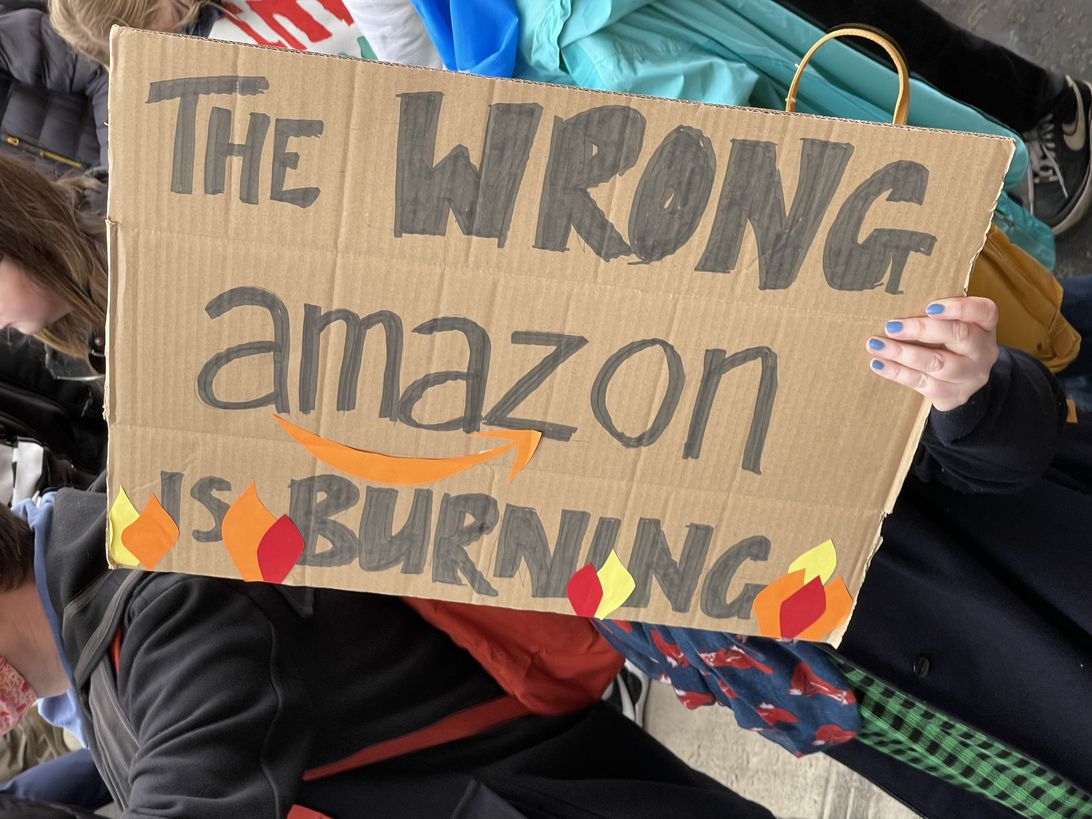Technologies
Big Tech at COP26: Here’s who attended the climate talks and what roles they played
If you blinked, you could’ve easily missed them. But all the biggest US tech companies were in attendance at the UN climate summit last week.

These days, when the world’s most important and powerful people gather to talk about matters of global consequence, executives from the world’s most powerful tech companies are usually in the room.
Discussions about Climate change are no exception. From power-hungry data centers to planet-spanning supply chains, tech can be a carbon-intensive business if not run correctly. And as the effects of the climate crisis — fires, floods, hurricanes and droughts — are being more keenly felt, technology companies have been increasingly vocal in the conversation about how to tackle the climate crisis.
Beyond making commitments to reducing their own carbon footprints, this means showing up at events like COP26, the UN climate summit, which took place in Glasgow, Scotland, the first two weeks of November.
Though world leaders and energy company execs took the most vocal roles at COP26, many of the biggest US tech companies also attended the summit, even though their levels of visibility varied.
Here’s what they were up to.
The Bezos in the room
By far the most visible tech figurehead at COP26 was former Amazon CEO Jeff Bezos — perhaps to his detriment. His presence at the UN summit got a mixed reception.
During his brief trip to Glasgow (he attended the two-week-long summit for somewhere between one to two days) Bezos announced that through his climate foundation, the Bezos Earth Fund, he’d donate an additional $2 billion toward landscape restoration and food systems transformation after being inspired to take care of the Earth after seeing it from the edge of space.
This made headlines but failed to impress climate activists, many of whom seemed deeply frustrated by the way Bezos engaged with the summit. It wasn’t so much his presence at COP26 that bothered them, but the fact that he used it as a PR opportunity rather than as a chance to listen to the voices of those most affected by the crisis, they said.
«These kinds of people, they shouldn’t be here giving speeches, they should be here and being targeted as responsible for these changes,»said Txai Surui, a 24-year-old Indigenous activist from Rondônia in Brazil.
«Why does he have more voice than young people that are suffering, or will suffer the consequences of the climate crisis?» asked Nicki Becker, a climate activist from Argentina. «Of course he has to be included in the conversation because he needs to first change his lifestyle.»
She added that billionaires and other top 1% earners like Bezos are most responsible for the climate crisis, so it’s hypocritical for them to turn up with purported solutions without making any effort to change their ways (Bezos flew in and out of Glasgow on his private jet).
Throughout the marches and climate protests that took place over the course of the summit, multiple people were carrying signs bearing variations on the words «We’re burning the wrong Amazon.»
The other billionaire
Former Microsoft CEO Bill Gates had a quieter presence at the summit than Bezos, attracting less criticism (even though he, too, appeared to fly in and out on a private jet).
Gates addressed world leaders, updating them on the progress of his climate initiative Breakthrough Energy Ventures and calling on them to come together to start a «green industrial revolution.»
He said he was spending his three days at the summit trying to encourage people to scale clean technology. «If we’re going to avoid the worst effects of a climate disaster, it’s not enough to invent zero-carbon alternatives — we need to make sure they’re affordable and accessible enough for people all over the world to use them,» he said.
He also urged rich- and middle-income countries to do more to help the areas that’ve done the least to cause climate change but are most affected by it.
It’s not clear, though, whether Gates spent any time at the summit talking with people from these areas. A criticism of many white, male leaders at the summit has been that they spent too much time talking and not enough time listening — especially to young black and Indigenous women who are leaders in the climate justice movement.
«Everybody brings us a different perspective on this,» Microsoft Chief Environmental Officer Lucas Joppa said in an interview, commenting on the role tech figureheads could play at COP. «Some of these individuals, they’ve grown businesses from nothing not just to global scale,» but to a scale that the world’s never seen before. «That is exactly what the world needs to do in its transition, when you look at renewable energy penetration in the markets, for instance.»
Behind the scenes
Ahead of the summit Apple, Facebook, Google and other companies announced new pledges to further improve their own sustainability credentials. But at the event they kept a fairly low profile.
Apple’s VP of Sustainability Lisa Jackson, posted on Twitter about attending COP26 and meeting with US President Joe Biden while there. At the summit Apple and Amazon signed on to the World Economic Forum’s First Movers Coalition, which aims to scale up emerging technologies essential to transitioning the globe’s economy to net-zero carbon by 2050.
Amazon CEO Andy Jassy said in a statement that joining the Coalition would «help further accelerate our efforts to decarbonize our operations through real business change and innovation.» (Jassy didn’t attend COP, but other execs from the company did.)
In an interview, Facebook Director of Global Sustainability Edward Palmieri said his role at the summit was to ensure the company was engaging in the right partnerships and coalitions to tackle the climate crisis.
«Our foundational work on sustainability, if it has taught us anything it’s that we not only have to take care of our own house and make sure that we’re in order from a sustainability perspective, but that global solutions are going to take us all working together to kind of get it done,» he said.
One of Palmieri’s focuses at the event was learning more water stewardship, so Facebook is able to meet its goal of restoring more water than it consumes by 2030. Water plays a huge role in cooling and maintaining the right level of humidity in Facebook’s global data centers, but the company says it recognizes water is also a shared community resource that needs to be restored so it doesn’t become polluted or scarce.
Microsoft also came to the summit hoping to learn as well as contribute, said Joppa. He was spending a portion of his time in Glasgow learning more about carbon removal and carbon accounting.
«The carbon removal markets today are wildly oversubscribed, and we need to fix that for the world and for Microsoft to meet its own goals,» he said. «We need much more common kinds of standards and definitions around the way we do accounting.»
Playing to the crowd
Microsoft was one of COP26’s principal sponsors, so as well as having its logo everywhere, it also had a stand in the «Green Zone» (the part of the summit open to the public). At its booth, it welcomed school children and other attendees to explore the company’s different initiatives as it works toward its goal of becoming carbon negative by 2030. The space also provided a platform for smaller companies to showcase their climate tech. These included NCX, a company Microsoft has invested in that uses aerial imagery and AI to survey forests.
Financing these companies is important, said Joppa, but so is giving them exposure to clients and customers via Microsoft’s platform. «How you all kind of hold hands and lift each other up is to actually help people become aware of all the solutions that are out there,» he said.
Other tech companies also focused their COP26 efforts on trying to use their reach to broaden access to the summit.
Google used its Arts and Culture project to take people from all over the world inside the Green Zone. Meanwhile, Facebook livestreamed conversations about climate science from a small booth within the UN pavilion at the summit.
Public awareness has been growing around COP for several years, and Facebook’s platforms can be harnessed to make and keep conversations around what happens at the UN climate summits on a global level, said Palmieri.
Instagram, in particular, has been a crucial platform for young climate activists from all over the world to engage their audiences and educate them about the climate crisis. During COP26, Emma Watson used her own Instagram presence to introduce her followers to many of these activists, who as well as doing vital work in their own communities, form a loosely grouped online activist network.
window.CnetFunctions.logWithLabel(‘%c One Trust ‘, «Service loaded: script_instagram with class optanon-category-5»);
But one thing Palmieri hopes to see happen is ensuring that information flows in both directions.
«What’s really important, and that I’m hoping our platform will be able to do more and more of, is to bring some of the experiences of climate change from certain parts of the world that maybe are less represented to decision makers and communities that are wealthier and have more of a voice,» he said.
Technologies
Today’s NYT Connections: Sports Edition Hints and Answers for Nov. 24, #427
Here are hints and the answers for the NYT Connections: Sports Edition puzzle for Nov. 24, No. 427.

Looking for the most recent regular Connections answers? Click here for today’s Connections hints, as well as our daily answers and hints for The New York Times Mini Crossword, Wordle and Strands puzzles.
Music lovers, today’s Connections: Sports Edition has a fun green category for you. You’ll recognize some familiar phrases in the grid, I think. If you’re struggling with today’s puzzle but still want to solve it, read on for hints and the answers.
Connections: Sports Edition is published by The Athletic, the subscription-based sports journalism site owned by The Times. It doesn’t appear in the NYT Games app, but it does in The Athletic’s own app. Or you can play it for free online.
Read more: NYT Connections: Sports Edition Puzzle Comes Out of Beta
Hints for today’s Connections: Sports Edition groups
Here are four hints for the groupings in today’s Connections: Sports Edition puzzle, ranked from the easiest yellow group to the tough (and sometimes bizarre) purple group.
Yellow group hint: Not long pants.
Green group hint: Sing out.
Blue group hint: Gridiron guys who share a name.
Purple group hint: Like a law.
Answers for today’s Connections: Sports Edition groups
Yellow group: Types of shorts.
Green group: Popular arena/stadium songs.
Blue group: Football Drews.
Purple group: ____ rule.
Read more: Wordle Cheat Sheet: Here Are the Most Popular Letters Used in English Words
What are today’s Connections: Sports Edition answers?
The yellow words in today’s Connections
The theme is types of shorts. The four answers are basketball, bike, compression and gym.
The green words in today’s Connections
The theme is popular arena/stadium songs. The four answers are Eye of the Tiger, Jump Around, Sandstorm and Thunderstruck.
The blue words in today’s Connections
The theme is football Drews. The four answers are Bledsoe, Brees, Lock and Pearson.
The purple words in today’s Connections
The theme is ____ rule. The four answers are infield fly, mercy, tuck and unwritten.
Don’t miss any of our unbiased tech content and lab-based reviews. Add CNET as a preferred Google source.
Technologies
Today’s NYT Mini Crossword Answers for Monday, Nov. 24
Here are the answers for The New York Times Mini Crossword for Nov. 24.

Looking for the most recent Mini Crossword answer? Click here for today’s Mini Crossword hints, as well as our daily answers and hints for The New York Times Wordle, Strands, Connections and Connections: Sports Edition puzzles.
Need some help with today’s Mini Crossword? Two down might be my favorite clue, and answer, this puzzle has ever offered. Read on for all of the answers. And if you could use some hints and guidance for daily solving, check out our Mini Crossword tips.
If you’re looking for today’s Wordle, Connections, Connections: Sports Edition and Strands answers, you can visit CNET’s NYT puzzle hints page.
Read more: Tips and Tricks for Solving The New York Times Mini Crossword
Let’s get to those Mini Crossword clues and answers.
Mini across clues and answers
1A clue: Prefix for some music genres
Answer: ALT
4A clue: Fab ___ (nickname for the Beatles)
Answer: FOUR
6A clue: Eagle’s claw
Answer: TALON
8A clue: Fab ___ (nickname for a noted University of Michigan basketball team)
Answer: FIVE
9A clue: Congregant’s seat
Answer: PEW
Mini down clues and answers
1D clue: Boat’s rear
Answer: AFT
2D clue: Shape of a cat with its legs tucked under itself
Answer: LOAF
3D clue: Flower that’s the subject of Dutch festivals
Answer: TULIP
5D clue: Wander aimlessly
Answer: ROVE
7D clue: Like many shows at the top of the Netflix queue
Answer: NEW
Don’t miss any of our unbiased tech content and lab-based reviews. Add CNET as a preferred Google source.
Technologies
Today’s Wordle Hints, Answer and Help for Nov. 24, #1619
Today’s Wordle is tricky. Here are hints, answers and help for Nov. 24, #1619.

Looking for the most recent Wordle answer? Click here for today’s Wordle hints, as well as our daily answers and hints for The New York Times Mini Crossword, Connections, Connections: Sports Edition and Strands puzzles.
Today’s Wordle puzzle is a little tricky. If you need a new starter word, check out our list of which letters show up the most in English words. If you need hints and the answer, read on.
Today’s Wordle hints
Before we show you today’s Wordle answer, we’ll give you some hints. If you don’t want a spoiler, look away now.
Wordle hint No. 1: Repeats
Today’s Wordle answer has no repeated letters.
Wordle hint No. 2: Vowels
Today’s Wordle answer has two vowels.
Wordle hint No. 3: First letter
Today’s Wordle answer begins with D.
Wordle hint No. 4: Last letter
Today’s Wordle answer ends with H.
Wordle hint No. 5: Meaning
Today’s Wordle answer is a flour-based mixture used to bake bread.
TODAY’S WORDLE ANSWER
Today’s Wordle answer is DOUGH.
Yesterday’s Wordle answer
Yesterday’s Wordle answer, Nov. 23, No. 1618 was BUNNY.
Recent Wordle answers
Nov. 19, No. 1614: MAKER
Nov. 20, No. 1615: GRAVE
Nov. 21, No. 1616: VOWEL
Nov. 22, No. 1617: THICK
-

 Technologies3 года ago
Technologies3 года agoTech Companies Need to Be Held Accountable for Security, Experts Say
-

 Technologies3 года ago
Technologies3 года agoBest Handheld Game Console in 2023
-

 Technologies3 года ago
Technologies3 года agoTighten Up Your VR Game With the Best Head Straps for Quest 2
-

 Technologies4 года ago
Technologies4 года agoBlack Friday 2021: The best deals on TVs, headphones, kitchenware, and more
-

 Technologies4 года ago
Technologies4 года agoVerum, Wickr and Threema: next generation secured messengers
-

 Technologies4 года ago
Technologies4 года agoGoogle to require vaccinations as Silicon Valley rethinks return-to-office policies
-

 Technologies4 года ago
Technologies4 года agoOlivia Harlan Dekker for Verum Messenger
-

 Technologies4 года ago
Technologies4 года agoiPhone 13 event: How to watch Apple’s big announcement tomorrow
